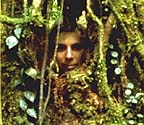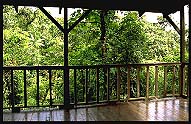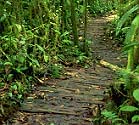 From EcoFuture ™
From EcoFuture ™
 From EcoFuture ™
From EcoFuture ™

Sandy Wiseman has witnessed and photographed not only the beauty you see here, but the tragedy of these rainforests being cleared by fire for development and export beef. If you are interested in visiting this rainforest yourself, or would like to help protect them in any other way, both Sandy and Rara Avis would be happy to hear from you.
Email Sandy at < sandy . wiseman @ utoronto . ca >
 Through the screened window at the head of my bed I could see the orange glow of the sun on the forest canopy across the river. I pulled on my field clothes, still damp, pants caked with mud below the knees, and went down to the deck high overlooking Atelophus creek.
I checked the weather (clear sky, cool, sweatshirt needed) and glanced at the green-fronted lancebill hummingbird nesting against the cabin just under the overhanging roof.
Through the screened window at the head of my bed I could see the orange glow of the sun on the forest canopy across the river. I pulled on my field clothes, still damp, pants caked with mud below the knees, and went down to the deck high overlooking Atelophus creek.
I checked the weather (clear sky, cool, sweatshirt needed) and glanced at the green-fronted lancebill hummingbird nesting against the cabin just under the overhanging roof.
Birds of many kinds were already active in the canopy, especially in two trees to the left of the deck. From high in the treetops, parrots and parakeets were squawking and feeding not just themselves but dozens of other creatures, with the fruit they carelessly dropped and scattered across the forest floor. With my binoculars, I saw more than a dozen other species but could identify only a couple without the field guide left on the stand beside the bed. After a few minutes taking in the air, always pleasant with a mingling of decay and perfume, my mind turned to coffee and breakfast at the Rara Avis lodge.
Fifteen minutes later, I grabbed my daypack (already stuffed with camera, binoculars, umbrella, waterproof bags, pocket knife, and water bottle), pulled on my black rubber boots, and headed off.

The trail was laid crosswise with narrow logs or planks over which chicken-wire was stapled to improve traction. But moss overgrew the wood and care was needed, especially in the morning when dew created a surface that could be treacherously slick. I walked slowly, pausing every few feet to scan the forest on both sides for birds or animals. I knew well that the odds of seeing something of interest were directly proportional to time spent looking. Most creatures of the forest, especially those active by day, are unobtrusive in appearance, habit, or both.